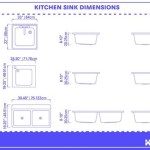How To Measure A Kitchen Sink For Replacement
Replacing a kitchen sink can be a significant upgrade to a kitchen, improving both its functionality and aesthetic appeal. However, before purchasing a new sink, accurate measurements are crucial to ensure a seamless installation and avoid costly mistakes. This article provides a comprehensive guide on how to properly measure a kitchen sink for replacement, covering various aspects of the process and offering practical tips for achieving accurate results.
Understanding Sink Anatomy and Terminology
Before diving into the measurement process, it's essential to understand the basic anatomy of a kitchen sink and the terminology used to describe its dimensions. Key terms include:
Overall Dimensions: These refer to the total length, width, and depth of the sink. The length is typically measured from the front to the back of the sink, the width from side to side, and the depth from the top of the rim to the bottom of the bowl.
Bowl Dimensions: These dimensions specify the length, width, and depth of the sink's bowl(s). For sinks with multiple bowls, each bowl's dimensions should be measured separately.
Rim or Flange: This is the edge of the sink that rests on the countertop. Its width and shape can influence the type of sink that can be installed.
Drain Opening: This refers to the diameter of the drain hole in the sink. Standard drain openings typically measure 3.5 inches in diameter.
Faucet Holes: The number and spacing of faucet holes are crucial for compatibility with the existing or intended faucet set. Determine the number of holes and the distance between the center of each hole.
Mounting Style: Kitchen sinks can be installed in various ways, including undermount, drop-in (top-mount), and apron-front (farmhouse) styles. Each mounting style requires specific measurements for a proper fit.
Step-by-Step Guide to Measuring Your Existing Sink
The following step-by-step guide outlines the process of accurately measuring your existing kitchen sink for replacement. It is recommended to use a measuring tape, paper, and pen for recording the measurements.
Step 1: Identify the Sink Mounting Style: Determine the type of sink you currently have. This will influence the areas you need to measure and the type of replacement sink that will fit. Common sink mounting styles include:
Drop-in (Top-Mount): These sinks have a rim that sits on top of the countertop. Measuring the overall dimensions of the sink is critical for these to ensure it covers the existing countertop cut-out. Be sure to measure the lip of the sink that sits on the countertop too.
Undermount: These sinks are installed beneath the countertop, with the countertop edge exposed. Measuring the interior dimensions of the cabinet and the cut-out in the countertop is essential for selecting an appropriate replacement.
Apron-Front (Farmhouse): These sinks have an exposed front that replaces a portion of the cabinet. Measuring the width and height of the cabinet opening is crucial for proper installation.
Step 2: Measure the Overall Dimensions: Using a measuring tape, measure the length and width of the sink from the outermost points. Ensure the measuring tape is straight and level for accurate readings. Record these measurements to the nearest 1/8 inch.
Step 3: Measure the Bowl Dimensions: For single-bowl sinks, measure the length, width, and depth of the bowl. For double-bowl sinks, measure each bowl separately. Pay attention to the shape of the bowls, as irregular shapes may require additional measurements.
Step 4: Measure the Depth of the Sink: Measure the depth of the sink from the top of the rim to the bottom of the bowl. This measurement is critical for ensuring that the new sink will fit within the cabinet below.
Step 5: Measure the Rim or Flange: Measure the width of the rim or flange that sits on top of the countertop. This measurement is particularly important for drop-in sinks, as the rim must fit within the existing countertop cutout.
Step 6: Measure the Drain Opening: Measure the diameter of the drain opening. Standard drain openings are typically 3.5 inches, but it's essential to verify the measurement to ensure compatibility with the existing or intended drain assembly.
Step 7: Measure the Faucet Holes: Count the number of faucet holes and measure the distance between the center of each hole. This measurement is crucial for selecting a replacement sink that is compatible with your existing or intended faucet set-up.
Step 8: Measure the Cabinet Interior (Undermount and Apron-Front Sinks): For undermount and apron-front sinks, measure the interior dimensions of the cabinet below the sink. This includes the width, height, and depth of the cabinet. These measurements are critical for ensuring that the new sink will fit properly within the cabinet.
Step 9: Measure the Countertop Cutout (Undermount Sinks): For undermount sinks, measure the dimensions of the countertop cutout. This involves measuring the length and width of the opening in the countertop where the sink will be installed. Be precise with these measurements, as they will directly impact the fit of the new sink.
Step 10: Record All Measurements: Record all measurements clearly and accurately. It's helpful to create a sketch of the sink and label each dimension. Double-check all measurements to ensure accuracy.
Key Considerations For Accurate Measurements
To ensure accurate measurements, consider the following key points:
Account for Overhang and Reveals: When measuring for undermount sinks, consider the desired overhang or reveal of the countertop edge. An overhang means the countertop extends slightly beyond the edge of the sink, while a reveal means the sink edge is slightly exposed. These factors will influence the dimensions of the countertop cutout.
Check for Obstructions: Before taking measurements, check for any obstructions within the cabinet or around the sink area. These may include pipes, garbage disposals, or other fixtures that could impact the fit of the new sink. Adjust the measurements accordingly to accommodate these obstructions.
Use a Laser Measuring Tool: For larger sinks or complex installations, consider using a laser measuring tool to ensure accurate and consistent measurements. These tools can provide precise readings and eliminate the potential for human error.
Existing Sink Templates: If available, use the existing sink as a template. Carefully trace the outline of the sink onto a piece of cardboard or template material. This template can be used to compare with the dimensions of potential replacement sinks and ensure a proper fit.
Important Notes for Different Sink Materials
The material of your existing sink can also influence the measurement process and the selection of a replacement sink. Consider these notes for different sink materials:
Stainless Steel: Stainless steel sinks are known for their durability and resistance to staining and corrosion. When measuring stainless steel sinks, pay attention to the gauge of the steel, as thinner gauges may be more prone to dents and scratches. Consider the thickness of the steel when selecting a replacement sink.
Cast Iron: Cast iron sinks are heavy and durable, but they can also be prone to chipping and cracking. When measuring cast iron sinks, take extra care to avoid damaging the surface. Also, consider the weight of the new sink when selecting a replacement, as it may require additional support from the cabinet below.
Granite Composite: Granite composite sinks are made from a blend of granite stone and resin. These sinks are resistant to heat, scratching, and staining. When measuring granite composite sinks, pay attention to the color and texture of the material, as variations can occur. Consider the overall aesthetic of the kitchen when selecting a replacement sink.
Fireclay: Fireclay sinks are made from a durable ceramic material that is fired at high temperatures. These sinks are resistant to chipping, cracking, and staining. When measuring fireclay sinks, pay attention to the dimensions and shape of the sink, as variations can occur. Also, consider the weight of the new sink when selecting a replacement, as it may require additional support from the cabinet below.
Double-Checking and Verifying Measurements
Once all measurements have been taken and recorded, it's essential to double-check and verify their accuracy. Consider the following steps:
Compare Measurements with Sink Specifications: Compare the recorded measurements with the specifications of potential replacement sinks. Look for sinks that closely match the dimensions of the existing sink, particularly the overall dimensions, bowl dimensions, and drain opening.
Consult with a Professional: If you're unsure about any of the measurements or have concerns about the installation process, consult with a professional plumber or contractor. They can provide expert advice and ensure that the new sink is properly installed.
Test Fit Before Installation: Before permanently installing the new sink, perform a test fit to ensure that it fits properly within the cabinet and countertop cutout. This will allow you to identify any potential issues and make necessary adjustments before it's too late.
Accurate measurements are vital for a successful kitchen sink replacement. By following this comprehensive guide and paying close attention to detail, one can ensure that the new sink fits properly and functions as intended, ultimately enhancing the overall look and functionality of the kitchen.

How To Measure For A Kitchen Sink In 5 Steps Modern Living

3 Ways To Measure A Kitchen Sink Wikihow

Quick Tip Tuesday How To Measure For A Replacement Undermount Kitchen Sink Youtube

3 Ways To Measure A Kitchen Sink Wikihow

A Practical Guide To Measure The Size Of Kitchen Sink

3 Ways To Measure A Kitchen Sink Wikihow

How To Choose A Kitchen Sink Capitol Kitchens And Baths

How To Choose A Kitchen Sink Grid Riverbend Home

Quick Tip Tuesday How To Measure For A Replacement Undermount Kitchen Sink Youtube

How Do I Know If The Strainer Can Fit My Drain







